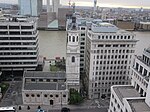St Magnus the Martyr, London Bridge, is a Church of England church and parish within the City of London. The church, which is located in Lower Thames Street near The Monument to the Great Fire of London, is part of the Diocese of London and under the pastoral care of the Bishop of Fulham. It is a Grade I listed building. The rector uses the title "Cardinal Rector" and, since the abolition of the College of Minor Canons of St Paul's Cathedral in 2016, is the only cleric in the Church of England to use the title Cardinal.St Magnus lies on the original alignment of London Bridge between the City and Southwark. The ancient parish was united with that of St Margaret, New Fish Street, in 1670 and with that of St Michael, Crooked Lane, in 1831. The three united parishes retained separate vestries and churchwardens. Parish clerks continue to be appointed for each of the three parishes.St Magnus is the guild church of the Worshipful Company of Fishmongers and the Worshipful Company of Plumbers, and the ward church of the Ward of Bridge and Bridge Without. It is also twinned with the Church of the Resurrection in New York City.Its prominent location and beauty have prompted many mentions in literature. In Oliver Twist Charles Dickens notes how, as Nancy heads for her secret meeting with Mr Brownlow and Rose Maylie on London Bridge, "the tower of old Saint Saviour's Church, and the spire of Saint Magnus, so long the giant-warders of the ancient bridge, were visible in the gloom". The church's spiritual and architectural importance is celebrated in the poem The Waste Land by T. S. Eliot, who wrote, "the walls of Magnus Martyr hold/Inexplicable splendour of Ionian white and gold". He added in a footnote that "the interior of St. Magnus Martyr is to my mind one of the finest among Wren's interiors". One biographer of Eliot notes that at first he enjoyed St Magnus aesthetically for its "splendour"; later he appreciated its "utility" when he came there as a sinner.











